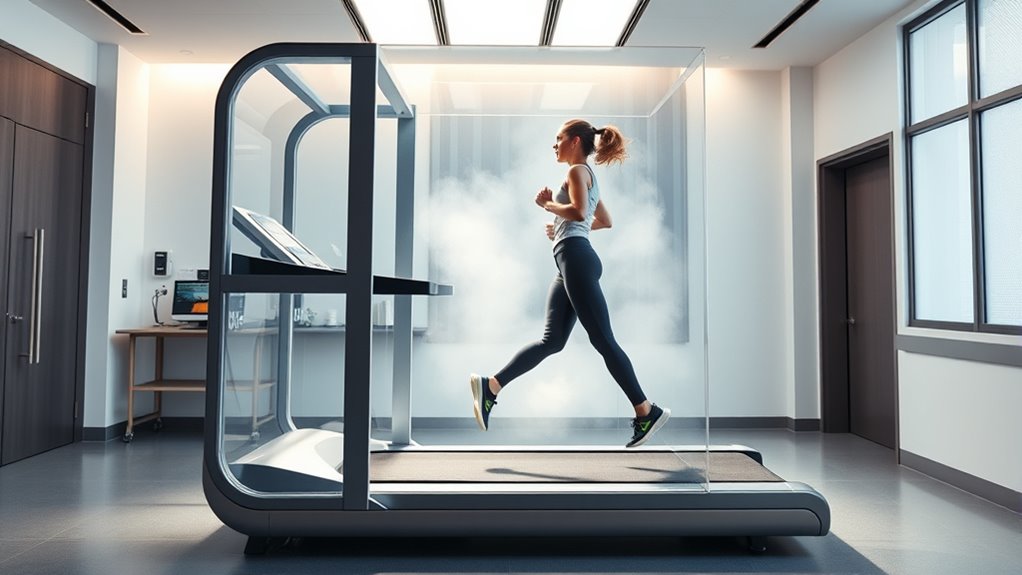You should consider using an anti-gravity treadmill during rehab, injury recovery, or when you want to improve your performance safely. It supports your body weight, reducing joint stress and allowing you to walk or run with less pain or fatigue. This device is great for gradually reintroducing activity, monitoring progress, and preventing future injuries. If you want to understand the best times and reasons to use an anti-gravity treadmill, keep exploring how it can benefit you.
Key Takeaways
- Use during rehabilitation to support early weight-bearing and promote safe, low-impact recovery.
- Employ for injury prevention by analyzing and correcting gait and running mechanics.
- Utilize in athletic training to boost performance and safely increase workout intensity.
- Implement for post-workout recovery to reduce joint stress and accelerate healing.
- Apply in controlled environments for precise weight support adjustments and real-time feedback.

Anti-gravity treadmills help you regain strength and mobility without risking further injury. If you’re recovering from surgeries, stress fractures, or soft tissue injuries, the reduced weight support enables you to start walking or running sooner than you could on a traditional treadmill. This gradual reintroduction of activity is essential for healing and helps prevent setbacks. Because the machine can precisely control the amount of body weight you support, your physical therapists can tailor your rehab program to match your healing stage. You can perform low-impact exercises that mimic natural movement, which accelerates recovery while minimizing pain and strain. Additionally, the controlled environment allows for proper hydration and nutrition, which are crucial in preventing fatigue and supporting healing. In athletic training, these treadmills serve as a powerful tool for improving performance and reducing injury risk. Athletes can push their limits safely by adjusting the level of weight support, allowing for high-intensity workouts without excessive joint stress. During training, you can simulate race conditions or focus on specific biomechanical aspects of your gait, stride, or running form. This targeted approach helps enhance efficiency, speed, and endurance. Additionally, anti-gravity treadmills enable you to recover faster after intense workouts. With less impact on your joints, you can continue training while your body heals from fatigue or minor injuries, ultimately maintaining consistency in your training schedule. Another key benefit is that anti-gravity treadmills provide immediate feedback on your movement patterns. This real-time data helps coaches and therapists identify issues, correct running mechanics, and prevent future injuries. Whether you’re working through a rehab protocol or aiming for peak athletic performance, the ability to monitor progress and make adjustments on the fly makes these devices invaluable.
Frequently Asked Questions
Are Anti-Gravity Treadmills Suitable for All Age Groups?
Anti-gravity treadmills aren’t suitable for all age groups, as there are age restrictions and potential physical limitations to take into account. You should consult with a healthcare professional to determine if it’s appropriate for your age and condition. While they offer benefits like reduced impact and support for injury recovery, younger children or older adults with certain health issues might need alternative options. Always prioritize safety and personalized advice.
How Do Anti-Gravity Treadmills Differ From Traditional Treadmills?
Imagine a treadmill where gravity takes a coffee break—that’s an anti-gravity treadmill. Unlike traditional models, it uses gravity simulation to reduce impact, making running easier on your joints. You get a smoother, more controlled workout, perfect for rehab or low-impact exercise. So, if you want impact reduction without sacrificing your stride, you’ll love how anti-gravity treadmills let you defy gravity—without leaving the ground.
Can Anti-Gravity Treadmills Help With Injury Recovery?
Yes, anti-gravity treadmills can substantially aid your injury recovery by providing rehabilitation benefits. They allow you to walk or run with reduced weight-bearing, easing stress on injured areas. This promotes safer, controlled movement, speeding up healing. Additionally, their support helps prevent further injury during recovery, making them an excellent tool for injury prevention and returning to activity confidently.
What Are the Cost Considerations for Anti-Gravity Treadmill Sessions?
Like steering uncharted waters, you’ll find that the cost analysis for anti-gravity treadmill sessions varies widely. Prices can range from $50 to $150 per session, and insurance coverage is often limited or unavailable. Consider your budget and speak with your provider to understand potential reimbursements. Weighing these costs against the benefits of faster recovery or improved training can help you decide if it’s a worthwhile investment.
Are There Any Long-Term Health Risks Associated With Anti-Gravity Treadmill Use?
Using an anti-gravity treadmill typically poses minimal long-term health risks if you follow proper guidelines. However, some concerns about long-term effects include potential joint or muscle imbalances from altered gait patterns or over-reliance on the device. To minimize health risks, guarantee you work with a professional, listen to your body, and incorporate traditional training. Regular assessments can help identify any adverse long-term effects early.
Conclusion
So, next time you step onto an anti-gravity treadmill, imagine the possibilities—how it could transform your recovery or boost your training. Will you push past limitations you once thought impossible? The technology is there, waiting for you to explore its potential. Don’t wait too long; the future of fitness and rehab is just beneath your feet, ready to lift you higher than ever before. Are you ready to take that step?









